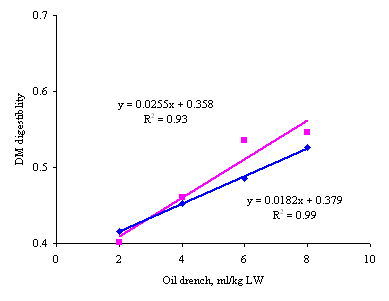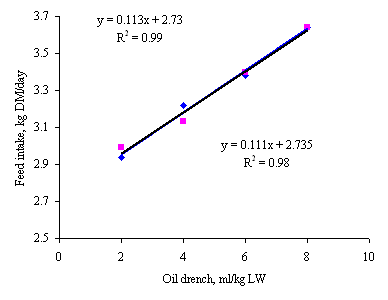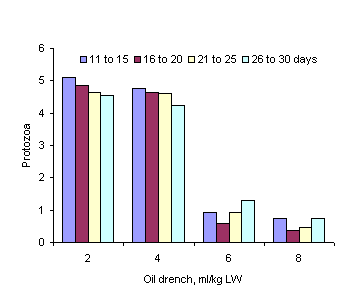Determination of the optimum level of a soybean oil drench with respect to the rumen ecosystem, feed intake and digestibility in cattle
Nguyen Thi Hong Nhan, Nguyen
Trong Ngu, Nguyen Thiet, T R
Preston* and R A Leng**
Cantho University, Cantho,
Vietnam
nthnhan@ctu.edu.vn
*UTA Colombia, AA48 Socorro,
Santander, Colombia
trpreston@mekarn.org
**PO Box 814, Coolum Beach 4573,
Australia
rleng@ozmail.com.au
Abstract
Four rumen-fistulated Sindhi-Yellow cattle were fed a basal diet of rice straw and grass (1:1 DM basis) and given a drench of 2, 4, 6 or 8 ml/kg LW of soybean oil in successive 30 day periods according to a 4*4 Latin square arrangement. Days 1 to 10 in each period were for adaptation (or re-faunation for 2nd, 3rd and 4th periods). The oil drench was given on day 11 with measurements of rumen ecology, feed intake and digestibility (total collection of faeces) in successive 5-day sub-periods (days 12-15; 16-20, 21-25, 26-30).
Oil treatment removed most of the protozoa, lowered the concentration of ammonia. and increased the numbers of bacteria. There were linear increases in DM intake and DM digestibility according to the level of oil drench in the periods 20 to 25 days, and 26 to 30 days, after giving the oil. The use of 6 ml of oil/kg is suggested as the most appropriate dose level
Keywords: Bacteria, digestibility, feed intake, oil drench, protozoa.
Introduction
Eliminating protozoa from the rumen with chemicals such as dioctyl sodium sulfosuccinate (Demeyer and Van Nevel 1979) ethoxylated nonyl phenol (Bird et al 1979) is a difficult procedure which occasionally results in the death of animals. Thus, despite the potential benefits in animal productivity (Bird et al 74), there was little impact of this technology at farmer level (R A Leng, personal communication).
Soybean oil containing elevated proportions of long-chain poly-unsaturated fatty acids was used to defaunate sheep by Broudiscou et al (1990). However, a practical way of applying this technology was only recently developed in Vietnam (Nguyen Thi Hong Nhan et al 2001, 2003) and confirmed in Cambodia (Mom Seng et al 2001), where it was shown that cattle fed a rice straw basal diet grew faster with better feed conversion, when drenched with groundnut oil at 5 ml/kg LW.
The following trial was set up to examine the response of cattle to different levels of an oil drench over the range 2 to 8 ml/kg LW.
Materials and methods
Four rumen-fistulated Sindhi-Yellow cattle were fed a basal diet of rice straw and grass (1:1 DM basis) and given a drench of 2, 4, 6 or 8 ml/kg LW of soybean oil in successive 30 day periods according to a 4*4 Latin square arrangement. Days 1 to 10 in each period were for adaptation (or re-faunation for 2nd, 3rd and 4th periods). The oil drench was given on day 11 with measurements of rumen ecology, feed intake and digestibility (total collection of faeces) in successive 5-day sub-periods ((days 12-16; 16-20, 21-25, 26-30).
Results and Discussion
The composition of diet ingredients is in Table 1.
|
Table 1. Chemical analysis of the feed components |
||||||
|
N*6.25 |
EE |
ADF |
NDF |
Ash |
||
|
89.4 |
5.9 |
1.4 |
39.4 |
67.1 |
15.4 |
|
|
17.7 |
11.6 |
4.0 |
31.7 |
59.6 |
11.9 |
|
As was observed also by Seng Mom et al (2001) and Chaudhary and Srivastava (1995), there was a depression of feed intake immediately after the animals were drenched with oil. However, recovery was rapid and intake had returned to normal 5 days after drenching. There were no differences in DM intake from day 12 to 20, but subsequently there was a positive linear relationship between oil level and DM intake (Table 2; Figure 1). Digestibility was higher in all periods for the animals that had been drenched with oil, the relationship being linear from day 21 to 25 and 26 to 30 (Figure 2).
|
Table 2. Intake and apparent digestibility of DM in periods between days 11 to 15 and days 16 to 20 after the oil drench |
|||||
|
Days in each period |
Oil supplement (ml/kg live weight) |
P |
|||
|
2 |
4 |
6 |
8 |
||
|
|
DM intake, kg |
||||
|
12-15 |
2.1 |
1.95 |
2.21 |
1.91 |
0.67 |
|
16-20 |
2.96 |
3.02 |
3.02 |
3.1 |
0.6 |
|
21-25 |
2.94a |
3.22ab |
3.38bc |
3.64c |
0.002 |
|
26-30 |
2.99a |
3.13ab |
3.40bc |
3.64c |
0.02 |
|
|
DM digestibility (%) |
||||
|
12-15 |
33.0a |
34.7ab |
42.8b |
39.3ab |
0.025 |
|
16-20 |
40.4a |
42.7a |
45.4ab |
49.1b |
0.015 |
|
21-25 |
41.6a |
45.2b |
48.6b |
52.6c |
0.001 |
|
26-30 |
40.1a |
46.1b |
53.6c |
54.6c |
0.001 |
|
abc Means in same row without common letter are different at P<0.05 |
|||||
|
|
 |
| Figure 1: Effect of level of oil drench on DM intake (21-25 days■ and 26-30 days ■) | Figure 2: Effect of level of oil drench on DM digestibility (21-25 days■ and 26-30 days ■) |
There are conflicting reports as to the extent that defaunation affects digestibility. Veira and Ivan (1983) reported a positive influence on apparent digestibility of both OM and starch. Similar results were found in buffaloes by Chaudhary and Srivastava (1995) and by Nguyen Thi Hong et al (2001) in cattle. In contrast, Rowe et al (1985) reported a significant reduction of OM digestibility in the whole digestive tract while Chaudhary et al (1998) found no difference in DM and OM digestibility in goats fed a straw-based diet with and without elimination of protozoa.
Raising the level of the oil drench decreased numbers of protozoa (Table 3; Figure 3) and increased those of bacteria (Table 4; Figure 4).
|
Table 3. Mean values for numbers of protozoa in rumen fluid taken before (0h) or 2 or 6h after feeding during days 11 to 15, 16-20, 21-25, 26-30 after the oil drench on day 11 |
|||||
|
|
Oil supplement (ml/kg live weight) |
P |
|||
|
|
2 |
4 |
6 |
8 |
|
|
|
Protozoa 0h (*10-5) |
|
|||
|
12-15 |
4.9 |
3.85 |
0.7 |
0.55 |
0.001 |
|
16-20 |
4.6 |
4.48 |
0.5 |
0.7 |
0.001 |
|
21-25 |
4.55 |
4.33 |
0.7 |
0.78 |
0.001 |
|
26-30 |
5.13 |
4.63 |
0.83 |
0.98 |
0.001 |
|
|
Protozoa 2h (*10-5) |
|
|||
|
12-15 |
5.1 |
4.75 |
0.93 |
0.73 |
0.001 |
|
16-20 |
4.85 |
4.65 |
0.6 |
0.38 |
0.001 |
|
21-25 |
4.65 |
4.6 |
0.93 |
0.45 |
0.001 |
|
26-30 |
4.55 |
4.23 |
1.3 |
0.73 |
0.001 |
|
|
Protozoa 6h (*10-5) |
|
|||
|
12-15 |
4.25 |
5.13 |
1.03 |
0.6 |
0.001 |
|
16-20 |
5.2 |
4.36 |
0.48 |
0.45 |
0.001 |
|
21-25 |
4.55 |
4.58 |
0.75 |
0.31 |
0.001 |
|
26-30 |
4.6 |
4.73 |
1.23 |
0.86 |
0.001 |
|
Table 4. Mean values for numbers of bacteria in rumen fluid taken before (0h) or 2 or 6h after feeding during days 11 to 15, 16-20, 21-25, 26-30 after the oil drench on day 11 |
|||||
|
|
Oil supplement (ml/kg live weight) |
P |
|||
|
2 |
4 |
6 |
8 |
||
|
|
Bacteria 0h, (*10-8) |
|
|||
|
11 to 15 |
4.32 |
4.41 |
4.07 |
5.22 |
0.9 |
|
16 to 20 |
4.23 |
4.3 |
6.68 |
9.23 |
0.004 |
|
21 to 25 |
4.37 |
4.98 |
7.45 |
9.69 |
0.001 |
|
26 to 30 |
4.63 |
5.75 |
10.53 |
12.04 |
0.006 |
|
|
Bacteria 2h, (*10-8) |
|
|||
|
11 to 15 |
4.158 |
4.03 |
4.47 |
5.78 |
0.6 |
|
16 to 20 |
4.48 |
5.46 |
7.02 |
11.11 |
0.006 |
|
21 to 25 |
5.15 |
5.53 |
8.89 |
10.65 |
0.001 |
|
26 to 30 |
5.09 |
6.03 |
9.74 |
11.3 |
0.003 |
|
|
Bacteria 6h, (*10-8) |
|
|||
|
11 to 15 |
4.41 |
4.01 |
5.13 |
5.68 |
0.7 |
|
16 to 20 |
4.22 |
5.62 |
6.63 |
9.58 |
0.01 |
|
21 to 25 |
5.21 |
5.94 |
8.76 |
10.44 |
0.001 |
|
26 to 30 |
5.01 |
6.36 |
10.53 |
11.33 |
0.001 |
|
|
|
|
Figure 3. Numbers of protozoa (*10-5) in rumen fluid in successive time periods after an oil dose of 2, 4, 6 or 8 ml kg/LW |
Figure 4. Numbers of bacteria (*10-8) in rumen fluid in successive time periods after an oil dose of 2, 4, 6 or 8 ml kg/LW |
Regardless of time after drenching, the oil at levels of 6 and 8 ml/kg live weight resulted in a major reduction of the population of protozoa. In contrast with the reduction of protozoa, the numbers of bacteria were increased by all levels of oil drench with the most marked increases for oil levels of 6 and 8 ml/kg live weight.
In the study done by Rowe et al (1985), the total number of bacteria was considerably higher in defaunated animals. The higher bacterial growth efficiency in the absence of the protozoa in the rumen is probably related to the fact that protozoa engulf and digest bacteria (Coleman 1975). This is supported by Leng (1990), who discovered that removal of protozoa or a decrease in protozoal density in the rumen can be expected to increase ruminant production under most feeding conditions pertaining to roughage fed ruminants.
Conclusions
-
Oil treatment removed most of the protozoa, lowered the concentration of ammonia. and increased the numbers of bacteria.
-
There were linear increases in DM intake and DM digestibility according to the level of oil drench in the periods 20 to 25 days, and 26 to 30 days, after giving the oil
-
The use of 6 ml of oil/kg is suggested as the most appropriate dose level
References
Bird S H and Leng
R A 1984 Further
studies on the effect of the presence or absence of protozoa in the
rumen on live weight and wool growth of sheep. Bri. J. Nutr. 52:
607.
Bird S H, Romulo
B and Leng R A 1994 Effect of lucerne supplementation and defaunation on feed
intake, digestibility, N retention and productivity of sheep fed
straw based diets. Animal Feed. Science and Tech. 45:
119-129.
Broudiscou L, van Nevel
C J and Demeyer D
I 1990 Effect of soya oil hydrolyzate on rumen digestion
in defaunated and refaunated sheep. Anim. Feed Sci. Tech. 30:
51
Demeyer D I
and Van Nevel C J 1979
Effect of defaunation on the metabolism of rumen micro-organism.
Br. J. Nutr. 42: 515-525
Nguyen Thi Hong Nhan, Nguyen Van Hon,
Nguyen Trong Ngu, Nguyen Tien Von, Preston T R and Leng R A
2001 Practical Application of Defaunation of Cattle on Farms in
Vietnam: Response of Young Cattle Fed Rice Straw and Grass to a
Single Drench of Groundnut oil. Asian-Aust. Journal Animal Science
Vol. 14, No.4: 485-490.
Seng Mom, Preston
T R and Leng R A
2001 Response of young cattle fed rice straw to supplementation
with cassava foliage and a single drench of cooking oil. Livestock
Research for Rural Development (13) 4: http://www.cipav.org.co/lrrd/lrrd13/4/seng134.htm


